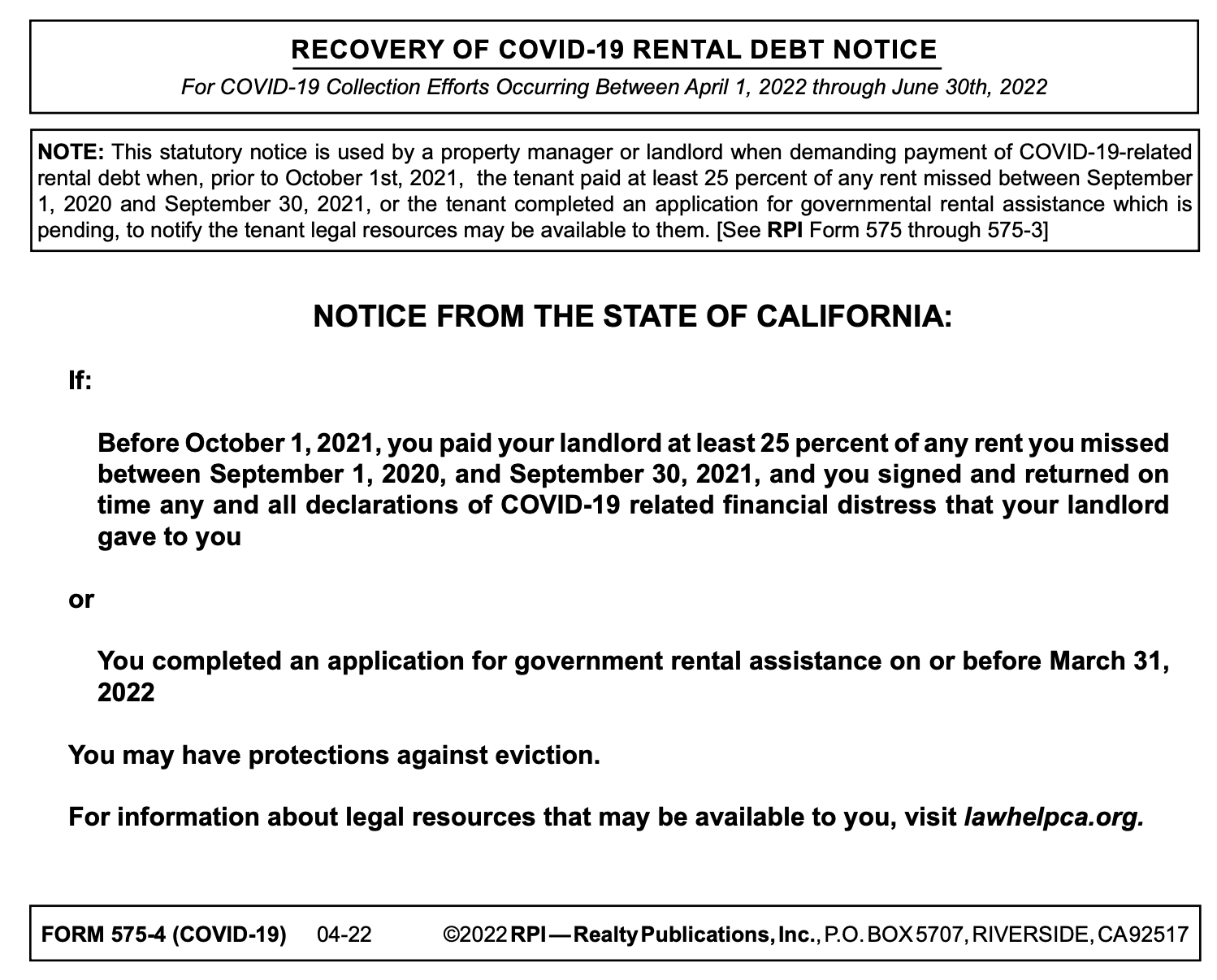A last-minute law change is extending the additional steps landlords need to take to evict a tenant due to nonpayment of rent.
The new law extends protection from eviction due to nonpayment of rent (or other financial obligations under the lease) which accumulated between March 1, 2020 and March 31, 2022 when an application for emergency rental assistance (ERA) has been submitted to Housing Is Key and is pending as of March 31, 2022.
Previously, this eviction protection was set to expire on March 31, 2022. This last-minute extension allows tenants who are still waiting on an ERA decision the chance to receive assistance and remain in their units.
Going into April 2022, there are still an estimated 165,000 – 190,000 tenant applicants with an active ERA application on file, according to AB 2179’s Bill Analysis. With this extension, these tenants will remain safe from eviction while their applications are being processed.
However, the new law does not apply to any missed rent accrued after April 1, 2022.
After April 1, 2022, local governments may pass their own protections for tenants with delinquent rent. But state-level protections against eviction cease for rent which is delinquent after March 31, 2022. [Calif. Code of Civil Procedure §1179.05]
New notice requirement
During the April 1, 2022 through June 30, 2022 window period, landlords seeking to evict a tenant due to delinquent rent that became due prior to April 1, 2022, are to provide the following statutory notice (cover letter) along with their notice to pay rent:

Realty Publications, Inc. (RPI) publishes this new rent assistance notice which is required beginning April 1, 2022.
The boilerplate notice is to be printed by the landlord or property manager and included along with the Three-day Notice to Pay being served. [See RPI Form 575-4]
Proper eviction procedures for ERA applicants
During the April 1, 2022 through July 30, 2022 window, a landlord will be unsuccessful in an unlawful detainer (UD) action, unless the court finds:
- the landlord completed an application for ERA to cover the amount of rental debt sought in the rental complaint which accumulated due to COVID-19 hardship; and
- the landlord’s ERA application was denied due to:
- lack of eligibility;
- lack of funding; or
- the tenant failing to properly complete their portion of the application within 15 business days after the landlord submitted their portion of the application. [CCP 1179.11(c)(2)(A)]
Separately, the UD action may be granted when the court finds there was no ERA application submitted and pending prior to April 1, 2022. [CCP §1179.11(c)(2)(B)]
When there is no pending ERA application or when the rent became delinquent after March 31, 2022, the landlord will revert to normal eviction procedures.
Proper eviction procedures under the TPA
California’s Tenant Protection Act (TPA) — passed in 2019 just before the pandemic temporarily upended eviction procedures — requires separate notices for different types of property and leases.
The TPA requires landlords to have just cause to evict tenants of properties built 15 or more years ago who have been a tenant for 12 months or more. Landlords lacking just cause to evict may need to provide financial relocation assistance, thus making it more difficult for landlords to evict tenants to rent out their properties to new tenants. [Calif. Civil Code §1946.2(a)]
To qualify for an at-fault just cause eviction, the tenant:
- defaulted on a rent payment;
- failed to enter into a landlord-requested renewal or extension of a lease which terminated on or after January 1, 2020 [See RPI Form 565];
- breached a material term of the lease;
- committed or permitted a nuisance or waste to occur on the property;
- conducted criminal activity on the premises or common areas, or used the premises for an unlawful purpose;
- assigned or sublet the premises in violation of the expired lease;
- refused the landlord’s authorized entry into the premises; or
- failed to deliver possession after providing the landlord notice to terminate the tenancy or surrender possession. [CC 1946.2(b)(1); See RPI Form 576-1]
With either of these notices, the landlord includes the additional cover letter notice concerning whether a tenant may be eligible for eviction protection while their ERA application is under review. This notice needs to be delivered with a Three-Day Notice to Pay Rent for delinquencies of rent accrued prior to April 1, 2022. [See RPI Form 575-4]
Once the three days have passed and the tenant has still not paid the required amount or communicated with the landlord that they have applied for rent assistance – the landlord may serve the tenant with a Three-Day Notice to Quit without the further opportunity for the tenant to cure the default in payment of rent. [See RPI Form 577-1]
Proper eviction procedures for tenants exempt from just cause evictions
For tenants who are not subject to just cause eviction requirements, the landlord serves the nonpaying tenant with a Three-Day Notice to Pay, along with the notice on the eviction protections available for tenants awaiting an ERA decision. [See RPI Form 575-1; Form 575-4]
Multi-unit residential real estate exempt from just cause eviction procedures include:
- residential units that have been issued a certificate of occupancy within the previous 15 years;
- a duplex of which the owner occupied one of the units as their principal residence at the beginning of the tenancy and remains in occupancy;
- units restricted as affordable housing for households of very low, low, or moderate income, or subject to an agreement that provides subsidies for affordable housing for households of very low, low, or moderate income;
- dormitories constructed and maintained in connection with any higher education institution in California;
- units subject to rent or price control that restricts annual increases in the rental rate to an amount less than that set by the TPA;
- multi-unit transient occupancy housing like hotels and motels;
- accommodations in which the tenant shares kitchen or bathroom facilities with an SFR owner-occupant;
- SFR real estate that can be sold and conveyed separate from the title to any other dwelling unit, like in a SFR subdivision or condominium project, provided:
- the owner is not one of the following:
- a real estate investment trust (REIT);
- a corporation; or
- a limited liability company (LLC) in which at least one member is a corporation; and
- the tenant has been given written notice stating the rental property is exempt from the rent increase caps under the TPA. [CC §1947.12(d); CC §1946.2(e); See RPI Form 550, 551and 550-3]
- the owner is not one of the following:
Related article:
As housing aid dwindles, California landlords have one last chance to apply for aid














